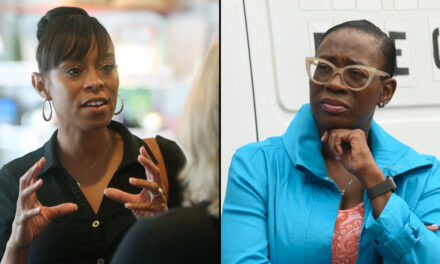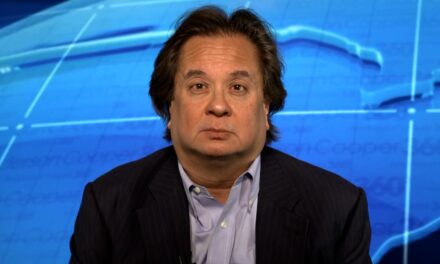
Opinion contributors: What we’re going to be watching closely tonight
Senior political analyst John Avlon: I’m going to be looking at how historic early voting levels upend campaign calculations: For example, what is the impact of a 600% increase in youth early voting in Texas? I’ll also be looking closely at the more than 200 pivot counties that voted twice for Barack Obama-Joe Biden and once for Donald Trump — do they flip back? Finally, my personal perennial obsession: How do independent voters break this time, and do they tip the scales in key battleground states?
Republican commentator Tara Setmayer: Given the dramatic demographic changes in states like Arizona, Texas and Georgia, and the collapse of support for Trump with suburban women, I’ll be paying close attention to results in Maricopa County, Arizona; the suburban counties in Texas; and Cobb and Gwinnett counties in Georgia, all traditionally red areas until now. Arizona has gone Republican for president every year since 1952, except 1996 for Bill Clinton, yet Joe Biden and Democrats are showing significant gains in the polls. Arizona could replace Ohio as a new bellwether state.
Trump biographer Michael D’Antonio: Since Florida and North Carolina, two battleground states, generally tally most of their votes by election night, I’ll focus my attention there first to see if President Donald Trump or Joe Biden takes an early lead. Next I’ll look for signs that in-person voting is strong enough to help Trump overcome Biden’s potential advantage in early voting.
Political commentator SE Cupp: Ever since Donald Trump was elected President in 2016, I’ve been watching one demographic in particular with a very close eye — white, suburban women. They helped him win four years ago, but since then they have been fleeing the Republican Party. Tonight, I’ll be watching whether they reaffirm their support to Trump for another four years, or whether they seek to return the purchase they made four years ago.
Political commentator Raul Reyes: While Joe Biden is leading Donald Trump among Latino voters by 2-to-1 in national polls, the figures for Latino voter turnout should be interesting to watch. In an election cycle marked by unprecedented mobilization efforts, Latino voters could play a decisive role in the presidential race in swing states like Arizona, Nevada, Florida and Texas.
Legal analyst Paul Callan: On election night, I will be watching to see if the Trump campaign tries to undermine the legitimacy of the results in order to create grounds for claiming election fraud. I will also be looking to see if voter turnout is less on Election Day, given the record early voting turnout. And I’ll be interested to see if Republican Sen. Lindsey Graham of South Carolina can survive his race against Democrat Jaime Harrison, the best funded candidate running for the US Senate.
Democratic commentator Nayyera Haq: I’m looking forward to Americans engaging with their democracy and turning out to vote in (hopefully) record numbers. We historically trail behind the rest of the developed world in voluntary voting participation: Israel and South Korea have nearly 80% of their voting population turnout for national elections, while we barely get half of our folks to show up at the polls. It’s sad it took the risk of autocracy and the near destruction of democratic norms for people to wake up and participate, but I hope the early voter enthusiasm we’ve seen so far continues to be the trend.
Political commentator Errol Louis: I will be watching to see if the national map is being redrawn. If Joe Biden wins Arizona, Georgia and Texas, it will be a political earthquake, signaling a fundamental shift in where Democrats are competitive. By the same token, if Donald Trump makes a breakthrough in the Midwestern “blue wall” by winning Michigan, Pennsylvania and Wisconsin for a second time, it will show that Republicans are making inroads there that could become permanent.
Conservative activist Jessica Anderson: I am looking to see if policy issues break through the noise for swing voters and animate their turnout and choice. We know the economic and health recovery from Covid-19, safety and security issues and immigration are important to many of these voters, but to what extent they motivate voters is what I will eager to see in the exit polls.
Historian Ruth Ben Ghiat: President Donald Trump has readied an army of lawyers to fan out across the country with the mandate of disputing results that could prevent his reelection. I will be watching to see if his authoritarian inclinations find their ultimate resolution in a premature declaration of victory on election night.
Democratic strategist Paul Begala: There is a “Rising American Electorate,” a new majority of young people, people of color and unmarried women. Perhaps because they’re progressive, some of them have been targeted for voter suppression efforts. On election night, I’ll be watching out for turnout levels among this energized constituency to see if they overcome any attempts to keep them from voting. Many are clustered in urban areas, so I’ll be paying close attention to returns from Philadelphia, Detroit, Milwaukee, Houston, Austin and Atlanta.
Senior legal analyst Laura Coates: I am anxious to see whether voter suppression and intimidation tactics profoundly impacted voter turnout. I am also particularly interested in seeing whether the Supreme Court will revisit its recent decisions regarding ballot deadline extensions and decide to weigh in on the legitimacy of cast ballots in a way that impacts the outcome of the race.
Republican commentator Scott Jennings: Kentucky, my home state, will be among the first to report robust results in the 7 o’clock hour. I’m looking at President Donald Trump’s margin of victory and especially his performance in the following suburban counties to discern clues for the rest of the night: Boone, Kenton, Campbell, Madison, Warren, Oldham and Daviess.
Democratic commentator Keith Boykin: In the entire history of the United States, there have been only 10 Black US senators. This year, Democrats have five new Black Senate candidates running in the South — Jaime Harrison in South Carolina, Raphael Warnock in Georgia, Mike Espy in Mississippi, Adrian Perkins in Louisiana and Marquita Bradshaw in Tennessee — and I’ll be looking to see how each of them does.
Republican strategist Lanhee Chen: Since 1952, voters in Arizona have only once picked a Democrat for president (in 1996, the state went to Bill Clinton). If Joe Biden is able to capture the state this year, it could be a real sign of trouble for Republicans in the desert Southwest, where they’ve steadily lost ground in previously competitive states like Nevada and New Mexico.
Political commentator Frida Ghitis: I will be looking to see if we detect any early signs of an overwhelming, crushing defeat of President Donald Trump, gauging for possible tremors that precede a landslide. I’m keeping an eye out for telltale, unexpectedly wide margins. A decisive victory could prevent disruptive and dangerous challenges in court and in the streets — or any other shenanigans.
Senior political analyst David Gergen: I will be watching not only who is winning, but how big a victory he is having. The bigger the triumph, the more likely the presidential winner’s party will also take the US Senate and state legislatures. On a personal note, I will watch Dan Feehan, a Democratic candidate in Minnesota’s 1st District, who is a military veteran, Teach for America alum and terrific former student. He is an underdog who has turned his congressional race into a toss-up.
Legal analyst Elie Honig: Will we, collectively, reject the false “whoever is ahead on November 3 wins” narrative and have the patience to let our election processes play out as prescribed by law? And will the courts reject efforts to short-circuit the full counting of all legally cast votes?
Political commentator Sarah Isgur: I’ll be watching Monroe County, Florida, on election night. President Barack Obama’s back-to-back victories in Monroe County (think Florida Keys) in 2008 and 2012 weren’t enough to keep it in the Democrats’ column in 2016. Trump won it by a comfortable almost seven points four years ago. But in 2018, the county split — former Democrat Sen. Bill Nelson won the county by 16 votes and Republican Gov. Ron DeSantis won it by 1,333 votes.
Political commentator Roxanne Jones: On election night, I’ll be watching poll results in my hometown of Philadelphia, where, as of mid-October, more than 1,120,000 city residents (more than 90% of all eligible voters) had registered to vote. Those are the highest numbers seen in decades, and if city turnout is high, that could be enough to counterbalance the support President Donald Trump saw in rural Pennsylvania in 2016, when he beat Hillary Clinton by less than one percentage point.
Democratic commentator Joe Lockhart: Demographics are changing throughout the country, but no place more so than the South and Southwest. If Arizona, Florida, Georgia, North Carolina and/or Texas turn blue on Election Day, 2020 will be seen as the tipping point for a younger, more progressive politics in America.
Conservative commentator Danielle Pletka: I keep being told that American democracy is at stake, broken, no longer respected in the world. So on election night I expect to enjoy the irony that all those uttering these dire warnings will be relying on the very system they insist no longer works to deliver a result that accords them the relief they seek. And I await with curiosity their reactions if our democracy results in another victory for Donald J. Trump.
Democratic commentator Van Jones: The big question is, will summer’s youth-led protests translate into a youthquake at the ballot box? Every cycle, we hear forecasts of a surge in youth vote, but these predictions rarely pan out. If this year is different, Donald Trump is likely toast.
Global affairs analyst Aaron David Miller: With gun sales soaring, unprecedented polarization and repeated triggering from President Donald Trump about the potential lack of legitimacy of election results, I’ll be looking for signs of coordinated voter suppression, intimidation and even the possibility of disruption at polling places. As returns are reported, I’ll be focused on Trump’s tweets and Justice Department statements about voter irregularities, litigation and fraud, and especially the President’s cueing and signaling to his base about preparation for a serious effort at contestation. As Varys said about Littlefinger in “Game of Thrones,” “He would see this country burn if he could be king of the ashes.”
Democratic strategist Patti Solis Doyle: I am looking out for the role that women voters will play in the 2020 election. I’m still reeling from the 2016 election when the country had an opportunity to elect its first woman president and fell short. Current polling has Joe Biden doing better than Hillary Clinton did in 2016 with all women, but especially White women. If that holds, I will be looking to see if that gain is based on a repudiation of President Donald Trump, or if women voters saw something in Biden that they didn’t see in Clinton.
Historian Julian Zelizer: I’m looking forward to the Texas results. If Joe Biden can pull off an upset or even comes in a very close second, we could be witnessing the start of the electoral collapse of the current Republican coalition. A good night for Democrats in Texas could also mean an opening for Democrats to expand their coalition in deeply red areas. If MJ Hegar could upset Sen. John Cornyn, that would mean we will probably see a sizable Senate Democratic majority. And if the statehouse turns blue in Texas, it would have massive ramifications for future redistricting.
Republican commentator Alice Stewart: I’ll be watching to see if 2016 repeats itself — will the many silent Trump voters who would not answer national polls, would not sport a bumper sticker and would not openly declare their support for the President turn up again and sway the national election? I suspect Election Day will be when they come out of shells, but only the evening’s results will tell for sure.
Journalist and filmmaker John Sutter: This election is a referendum on the climate crisis. I’ll be watching exit polls and results to see if young people are turning out in large numbers, especially those in the South, who are recovering from Hurricane Zeta, and those in the West, who have had to face a monstrous wildfire season.
National security analyst Samantha Vinograd: I am often the bearer of bad news so I will start with some good news for a change: I am looking at the US voter turnout. Amid attacks on our democracy from both foreign and domestic actors, Americans are showing up to do their civic duty in record numbers. That’s a strong message of resilience. On the flip side, I’m monitoring multiple threat streams. From cyberattacks on election infrastructure and disinformation campaigns to stoke confusion and civil unrest, there are multiple flashpoints at play, particularly because President Donald Trump stokes threats rather than trying to mitigate them.

















